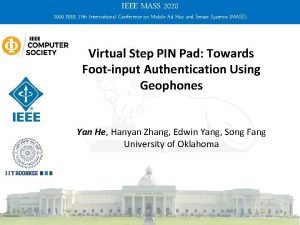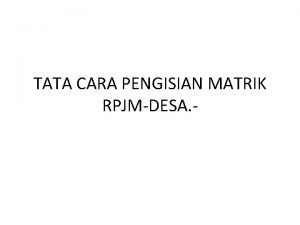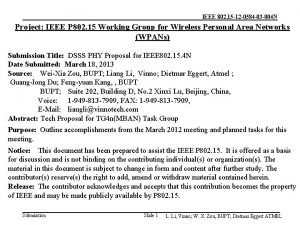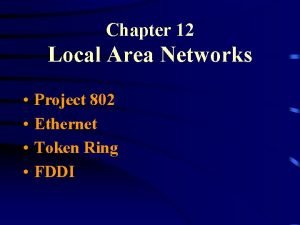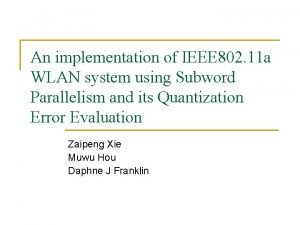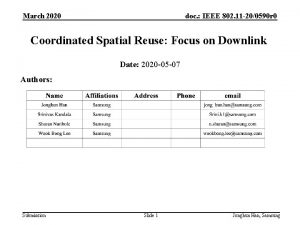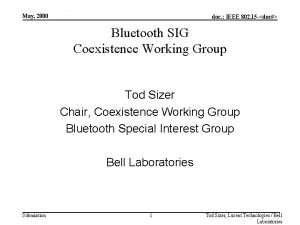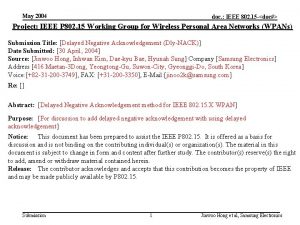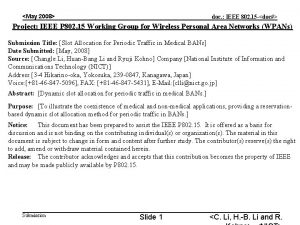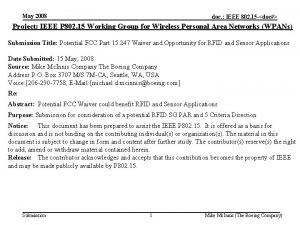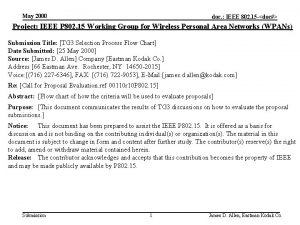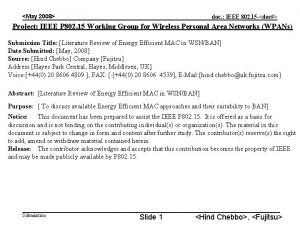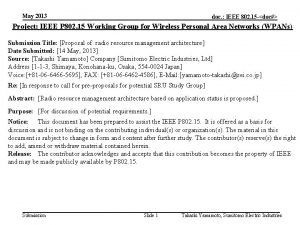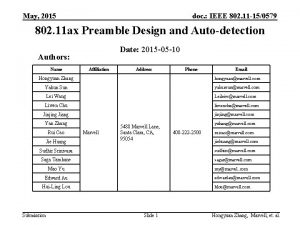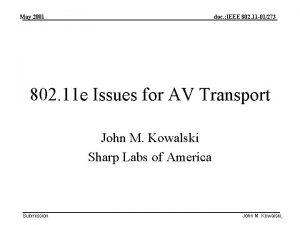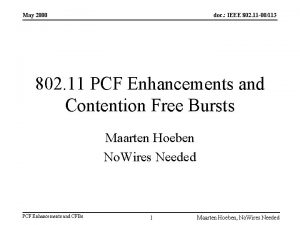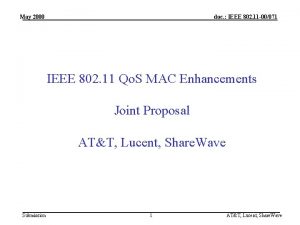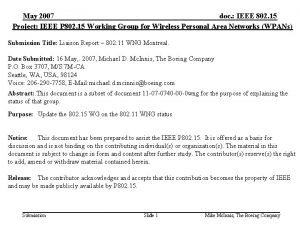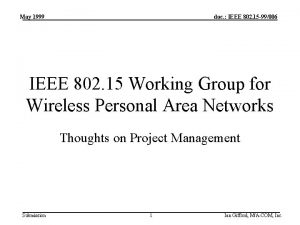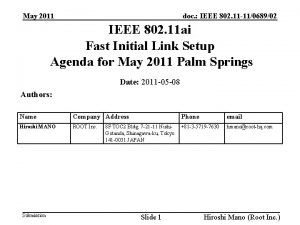May 2020 doc IEEE 802 11 200590 r















![May 2020 doc. : IEEE 802. 11 -20/0590 r 4 Reference [1] 802. 11 May 2020 doc. : IEEE 802. 11 -20/0590 r 4 Reference [1] 802. 11](https://slidetodoc.com/presentation_image_h2/924fa9c0ebfe5d6f06c638dcec77e5ab/image-16.jpg)




- Slides: 20

May 2020 doc. : IEEE 802. 11 -20/0590 r 4 Coordinated Spatial Reuse: Focus on Downlink Date: 2020 -05 -07 Authors: Submission Slide 1 Jonghun Han, Samsung

May 2020 doc. : IEEE 802. 11 -20/0590 r 4 Recap: Coordinated SR (C-SR) • C-SR is a simple Multi-AP coordination scheme that can increase spectrum efficiency by reusing the same time/frequency resources among multiple BSSs • C-SR procedure – C-SR procedure with unsolicited method [1] – General C-SR procedure [2] • C-SR performance gain – Compared to OBSS-PD and TDD [3] – Compared to EDCA and complete control [4] – Compared to C-OFDMA and OBSS-PD [5] • In this contribution, we divide the downlink (DL) C-SR procedure into 3 phases and investigate several issues of C-SR operation Submission Slide 2 Jonghun Han, Samsung

May 2020 doc. : IEEE 802. 11 -20/0590 r 4 AP Issue 1: C-SR Coordination Policy • • • [Option 1] C-SR gain comes from appropriate Tx power management DL TX Sharing AP Option 1: bi-directional coordination – Sharing AP and shared AP negotiate the appropriate Tx power combination – Could be better in terms of sum throughput – Additional signaling overhead STA Shared AP Negotiated power Option 2: one-way coordination (Preferred) Enough power – Sharing AP determines Tx power without a coordination process and limits the Tx power of shared AP to protect transmissions of sharing AP – Sharing AP does not need to sacrifice its performance – Less overhead Sharing AP Shared AP Less power [Option 2] Submission Slide 3 Jonghun Han, Samsung

May 2020 doc. : IEEE 802. 11 -20/0590 r 4 C-SR Procedure into 3 Phases • 1 3 AP 1 AP 2 AP STA Signal 2 Submission Slide 4 4 Jonghun Han, Samsung

May 2020 doc. : IEEE 802. 11 -20/0590 r 4 C-SR Procedure into 3 Phases 2. Announcement phase: after AP obtains TXOP – If the AP is willing to share the obtained TXOP, it becomes a sharing AP – Sharing AP’s action list • Select the shared AP from the AP candidate set – Considering DL STA’s SINR of sharing AP • Trigger the shared AP’s transmission using announcement frame – Essential information: AP ID, Tx power limit 3. Transmission phase: after the potential shared AP obtains the shared TXOP – If an AP receives the announcement frame successfully and is willing to participate in the C-SR transmission, the AP becomes a shared AP – Shared AP’s action list • Set Tx power based on the guide obtained from the announcement frame – C-SR transmissions (including block acknowledgement) of the sharing/shared APs occur simultaneously in the shared TXOP – Assumption: start/end time of C-SR transmissions are aligned Submission Slide 5 Jonghun Han, Samsung

May 2020 doc. : IEEE 802. 11 -20/0590 r 4 Issue 2: Obtaining/Delivering Path Loss • AP who is willing to share its TXOP requires … ① Path loss with neighboring C-SR capable AP ü Can obtain from a measurement ② Path loss with associated STA ü Can obtain from a report ③ Path loss between associated STA and neighboring C-SR capable AP ü Can obtain from a report • How to calculate path loss? – STA can use beacon as a reference of path loss estimation – (Beacon Tx power) – (Beacon Rx signal strength) • We need an element or a field which indicates beacon Tx power information. C-SR capable AP can include the element or the field in the beacon frame. Submission Slide 6 Jonghun Han, Samsung

May 2020 doc. : IEEE 802. 11 -20/0590 r 4 Issue 2: Obtaining/Delivering Path Loss • 1 2 AP 1 Submission Slide 7 AP 2 Jonghun Han, Samsung

May 2020 doc. : IEEE 802. 11 -20/0590 r 4 C-SR Procedure Example: 2 -BSS DL/DL • AP 1 obtains TXOP sharing AP Collecting Capability/Path loss AP 1 • AP 2 obtains the shared TXOP shared AP C-SR-A DL MU BA STA 1 -1 BA STA 1 -2 DL MU AP 2 STA 2 -1 Measuring and Collecting Path loss Report BA BA STA 2 -2 Preparation Phase * C-SR-A: C-SR announcement frame Submission Announcement Phase Transmission Phase Measurement Report Slide 8 Jonghun Han, Samsung

May 2020 doc. : IEEE 802. 11 -20/0590 r 4 Issue 3: Block Acknowledgement (BA) Separation • Problem – BA transmissions of STAs simultaneously occur in the shared TXOP – Tx power limit applies to shared AP’s transmission • Solution – Separation of BA transmissions of the STAs associated with sharing/shared AP • Options for BA separation – [Option 1] Non-overlapping resources for BA (preferred) • Allocate non-overlapping frequency resources for BAs of sharing/shared AP • Non-overlapping frequency resource allocation for BA is determined by the sharing AP and included in the announcement frame – [Option 2] Implicit BA for sharing AP side, and delayed BA for shared AP side • Pros: simple • Cons: overhead Submission Slide 9 Jonghun Han, Samsung

May 2020 doc. : IEEE 802. 11 -20/0590 r 4 Issue 3: Block Acknowledgement (BA) Separation • [Option 1] Non-overlapping resources for BA in detail – Two-level BA separation • Level 1: BA separation among sharing/shared APs – E. g. upper 40 MHz for sharing AP, lower 40 MHz for shared AP • Level 2: BA separation between DL STAs in each BSS (DL MU PPDU case) – STAs send the immediate response according to the resource allocation information that is carried in the TRS control subfield frequency BA of STA 1 80 MHz C-SR Transmission of sharing AP (DL MU PPDU) 3 BA of STA 2 Shared AP SIFS 1 same 80 MHz time frequency 4 Sharing AP 80 MHz C-SR Transmission of shared AP (DL MU PPDU) 2 BA of STA 3 BA of STA 4 Submission Slide 10 time Jonghun Han, Samsung

May 2020 doc. : IEEE 802. 11 -20/0590 r 4 Summary • We divide C-SR procedure into 3 phases according to TXOP acquisition status of sharing/shared AP • We believe that one-way coordination is an appropriate policy to manage the Tx power of sharing/shared AP in C-SR operation • To determine the maximum Tx power of shared AP, sharing AP collects path loss information from the associated STAs and neighboring C-SR capable APs by soliciting reports • We propose two options for BA separation Submission Slide 11 Jonghun Han, Samsung

May 2020 doc. : IEEE 802. 11 -20/0590 r 4 Straw Poll #1 • Do you agree that in 11 be sharing AP limits the shared AP(s)’ transmission power during the shared TXOP in C-SR procedure? – Sharing AP may reduce its transmission power in the shared TXOP – Shared AP(s) shall follow the transmission power limit indicated by sharing AP in the shared TXOP – Shared AP’s transmission power limit is included in the announcement frame – NOTE: the term, shared TXOP, can be changed – NOTE: the field indicating transmission power limit and its encoding are TBD Submission Slide 12 Jonghun Han, Samsung

May 2020 doc. : IEEE 802. 11 -20/0590 r 4 Straw Poll #2 • Do you agree that in 11 be C-SR capable AP indicates its beacon transmission power in beacon frame? – The beacon transmission power can be included in either one of element or field – The element or field indicating the beacon transmission power and its encoding are TBD Submission Slide 13 Jonghun Han, Samsung

May 2020 doc. : IEEE 802. 11 -20/0590 r 4 Straw Poll #3 • Do you agree that in 11 be the signaling for reporting path loss values is required? – Signaling details are TBD Submission Slide 14 Jonghun Han, Samsung

May 2020 doc. : IEEE 802. 11 -20/0590 r 4 Straw Poll #4 • Do you agree that in 11 be sharing AP allocates non-overlapping frequency resources of block acknowledgements for each sharing AP and shared AP(s) for C-SR operation? – Allocating non-overlapping frequency resource shall be determined by sharing AP – The way of indicating non-overlapping frequency resources for block acknowledgement is TBD Submission Slide 15 Jonghun Han, Samsung
![May 2020 doc IEEE 802 11 200590 r 4 Reference 1 802 11 May 2020 doc. : IEEE 802. 11 -20/0590 r 4 Reference [1] 802. 11](https://slidetodoc.com/presentation_image_h2/924fa9c0ebfe5d6f06c638dcec77e5ab/image-16.jpg)
May 2020 doc. : IEEE 802. 11 -20/0590 r 4 Reference [1] 802. 11 -20/0410 r 4 “Coordinated Spatial Reuse Procedure”, Sungjin Park [2] 802. 11 -20/0576 r 1 “Coordinated Spatial Reuse Protocol”, Yongho Seok [3] 802. 11 -20/0457 r 1 “Discussion on Coordinated Spatial Reuse Operation”, Kosuke Aio [4] 802. 11 -20/0107 r 1 “Multi-AP coordination for spatial reuse”, Dmitry Akhmetov [5] 802. 11 -20/0073 r 0 “On Coordinated Spatial Reuse in 11 be”, Jianhan Liu Submission Slide 16 Jonghun Han, Samsung

May 2020 doc. : IEEE 802. 11 -20/0590 r 4 APPENDIX Submission Slide 17 Jonghun Han, Samsung

May 2020 doc. : IEEE 802. 11 -20/0590 r 4 Calculation of Shared AP’s Tx Power Limit • 1 3 AP 1 AP 2 AP STA Signal 2 Submission 4 Slide 18 Jonghun Han, Samsung

May 2020 doc. : IEEE 802. 11 -20/0590 r 4 Measurement Request/Report • Action frame: Radio Measurement Request/Response frame • Measurement Request/Report element • Measurement type and Report field definitions Submission Slide 19 Jonghun Han, Samsung

May 2020 doc. : IEEE 802. 11 -20/0590 r 4 Transmit Power Used Field • 8 -bit field • Link Measurement Request Frame Submission Slide 20 Jonghun Han, Samsung
 Bridges from 802.x to 802.y
Bridges from 802.x to 802.y Bridges from 802.x to 802.y
Bridges from 802.x to 802.y Estandar ieee 802
Estandar ieee 802 802 ieee
802 ieee Ieee 802 family
Ieee 802 family Wlan standards
Wlan standards Ieee 802 standard
Ieee 802 standard Ieee 802
Ieee 802 Ieee 802 3 compliance
Ieee 802 3 compliance Arquitetura ieee 802
Arquitetura ieee 802 Bluetooth ieee 802
Bluetooth ieee 802 Ieee mass 2020
Ieee mass 2020 Format rps dikti 2021 doc
Format rps dikti 2021 doc Format matrik rpjm desa
Format matrik rpjm desa Rejestr wypadków przy pracy 2020 doc
Rejestr wypadków przy pracy 2020 doc Hci patterns may or may not include code for implementation
Hci patterns may or may not include code for implementation Mac address
Mac address 802 15
802 15 802*12
802*12 Wlan 802
Wlan 802 Geo 802
Geo 802











